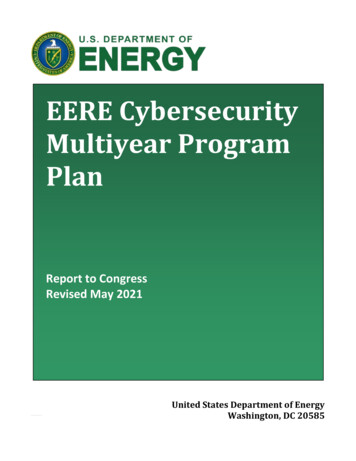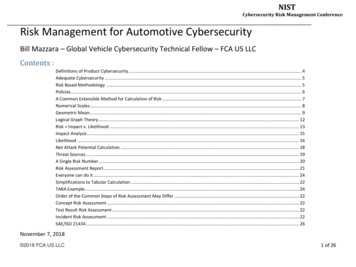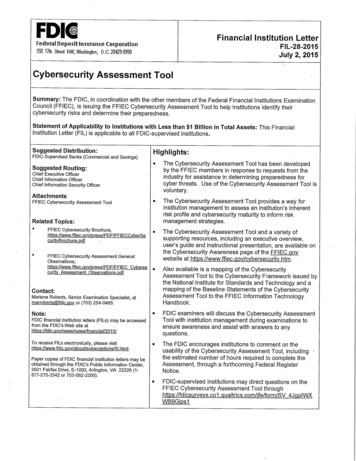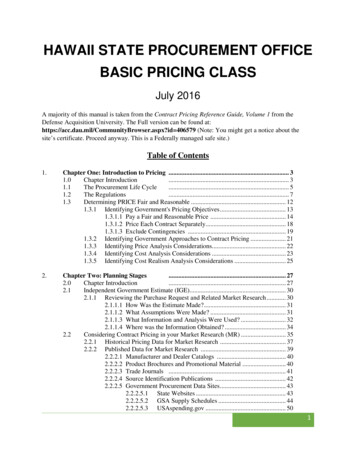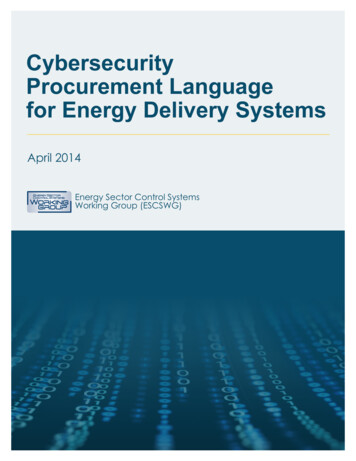
Transcription
CybersecurityProcurement Languagefor Energy Delivery SystemsApril 2014Energy Sector Control SystemsWorking Group (ESCSWG)
For Questions or CommentsEnergy sector asset owners, operators, and suppliers are encouraged to provide feedback on thisdocument to enhance the cybersecurity procurement language for future versions. Please sendquestions or comments to es-pl@energetics.com.AcknowledgementsThis document was prepared by the Energy Sector Control Systems Working Group (ESCSWG), PacificNorthwest National Laboratory (PNNL), and Energetics Incorporated, with funding from the U.S.Department of Energy (DOE) Office of Electricity Delivery and Energy Reliability (OE) Cybersecurity forEnergy Delivery Systems (CEDS) program, and in collaboration with the U.S. Department of HomelandSecurity (DHS) Industrial Control Systems Cyber Emergency Response Team (ICS-CERT), Duke Energy,Edison Electric Institute (EEI), the Electric Power Research Institute (EPRI), the Federal EnergyRegulatory Commission (FERC), the Independent Electric System Operator (IESO) in Ontario, and theUtilities Telecom Council (UTC). Contributions were also provided by the American Public PowerAssociation (APPA), American Gas Association (AGA), and Idaho National Laboratory (INL).A special thanks to Ed Goff of Duke Energy for his dedication and leadership in guiding this effort. Also,a special thanks to the many unlisted stakeholders and experts who provided comments and feedbackduring the two comment review periods for this document.DisclaimerThis material was prepared as an account of work sponsored in part by an agency of the United StatesGovernment. Neither the ESCSWG, nor the United States Government nor any agency thereof, nor anyof their employees, nor the technical contributors to this document or their employers, MAKES ANYWARRANTY, EXPRESSED OR IMPLIED, or assumes any legal liability or responsibility for the accuracy,completeness, or usefulness of any information or processes disclosed, or represents that its usewould not infringe privately owned rights.i
ContentsFor Questions or Comments . iAcknowledgements . iDisclaimer . i1. INTRODUCTION . 11.1Cybersecurity of Energy Delivery Systems . 11.2Background on Cybersecurity Procurement Language . 11.3Procurement Aligns with Energy Sector Cybersecurity Initiatives . 21.4About this Document . 31.5How to Use this Document . 51.6Examples of How to Use this Document . 102. GENERAL CYBERSECURITY PROCUREMENT LANGUAGE . 132.1Software and Services . 132.2Access Control. 142.3Account Management . 152.4Session Management. 162.5Authentication/Password Policy and Management . 162.6Logging and Auditing . 172.7Communication Restrictions . 182.8Malware Detection and Protection . 202.9Heartbeat Signals . 212.10Reliability and Adherence to Standards. 213. THE SUPPLIER’S LIFE CYCLE SECURITY PROGRAM . 233.1Secure Development Practices . 233.2Documentation and Tracking of Vulnerabilities . 243.3Problem Reporting . 253.4Patch Management and Updates . 263.5Supplier Personnel Management . 273.6Secure Hardware and Software Delivery . 274. INTRUSION DETECTION. 294.1Host Intrusion Detection. 294.2Network Intrusion Detection . 295. PHYSICAL SECURITY . 31ii
5.1Physical Access to Energy Delivery System Components . 315.2Perimeter Access . 315.3Communications inside the Physical Security Perimeter . 326. WIRELESS TECHNOLOGIES . 336.1.General Wireless Technology Provisions . 337. CRYPTOGRAPHIC SYSTEM MANAGEMENT . 347.1.Cryptographic System Documentation . 347.2.Cryptographic Key and Method Establishment, Usage, and Update . 348. REFERENCES . 369. ABBREVIATIONS AND ACRONYMS . 3910. GLOSSARY . 4111. ADDITIONAL ACKNOWLEDGEMENTS. 42iii
1. INTRODUCTION1.1Cybersecurity of Energy Delivery SystemsEnergy delivery systems are critical to the effective and reliable operation of North America’s energyinfrastructure. Our twenty-first-century way of life is made possible by the vast network of processesenabled by these systems, as well as the interconnected electronic components, communicationdevices, and people who monitor and control those processes. Energy delivery systems are used tomonitor and control the production, transfer, and distribution of energy. These systems includeSupervisory Control and Data Acquisition (SCADA) systems, Energy Management Systems (EMSs),Distribution Management Systems (DMSs), and Distributed Control Systems (DCSs). Energy deliverysystems comprise the following: The sensors and actuators used for monitoring and controlling energy delivery processes.The computer-based systems that analyze and store data.The communication pathways and networks that interconnect the various computer systems.Cybersecurity threats, whether malicious or unintentional, pose a serious and ongoing challenge forthe energy sector. Today’s highly reliable and flexible energy infrastructure depends on the ability ofenergy delivery systems to provide timely, accurate information to system operators and automatedcontrol over a large, dispersed network of assets and components. A cyberattack on an energydelivery system can have significant impacts on the availability of a system to perform criticalfunctions as well as the integrity of the system and the confidentiality of sensitive information. This, inturn, could impact national security, public safety, and the economy.A variety of steps need to be taken throughout the life cycle of energy delivery systems to protectthem from cyber threats. Embedding cybersecurity in the procurement of energy delivery systems isan important step for protecting these systems and is the focus of this document. Includingcybersecurity in the procurement process can ensure that those purchasing and supplying energydelivery systems consider cybersecurity starting from the design phase of system development. Thisfurther ensures that cybersecurity is implemented throughout the testing, manufacturing, delivery,installation, and support phases of the product life cycle, improving overall reliability and reducingcybersecurity risks. To assist with embedding cybersecurity in the procurement of energy deliverysystems, this document provides baseline cybersecurity procurement language for use by assetowners, operators, integrators, and suppliers during the procurement process.1.2Background on Cybersecurity Procurement LanguageThe U.S. Department of Energy (DOE) and the U.S. Department of Homeland Security (DHS)collaborated with industry cybersecurity and control system subject matter experts to publish CyberSecurity Procurement Language for Control Systems in 2009 (henceforth referred to as DHS [2009]).The development of DHS (2009) brought together leading control system security experts, assetowners and operators, integrators, and suppliers across many sectors (e.g., electricity, natural gas,petroleum and oil, water, transportation, and chemical), as well as representatives from federal andstate governments and international stakeholders.1
The DHS (2009) document summarizes security principles and controls to consider when designing andprocuring control system products and services (e.g., software, systems, maintenance, and networks),and provides example language that could be incorporated into procurement specifications. Thedocument was intended as a “toolkit” to reduce energy delivery systems’ cybersecurity risk by askingsuppliers to assist in managing known vulnerabilities and deliver more secure systems.The information provided in DHS (2009) was not intended to replace the application of good engineeringpractices or judgment; instead, the intent was to encourage suppliers and acquirers of energy deliverysystems to work together to identify risk mitigation strategies specific to their system(s). It built on thepremise that an energy delivery system’s prime functions, design, and expected behaviors need to beconsidered prior to adding or requesting security features through the procurement process.1.3Procurement Aligns with Energy Sector Cybersecurity InitiativesSeveral efforts have been developed and are underway in the energy sector to help address theevolving cybersecurity challenges faced by the sector. This procurement language documentcomplements other cybersecurity efforts by providing organizations that acquire, integrate, andsupply energy delivery systems with guidance on how to communicate cybersecurity expectations in aclear and repeatable manner.The Roadmap to Achieve Energy Delivery Systems Cybersecurity, developed by the Energy SectorControl Systems Working Group (ESCSWG) in 2011, provides a common vision and strategicframework to guide industry and government partnerships that will secure energy delivery systems.The roadmap vision is that by 2020, these systems will be designed, installed, operated, andmaintained to survive a cyber incident while sustaining critical energy delivery functions. Theroadmap’s strategic framework includes strategies and milestones linked to distinct time frames forcompletion to help guide coordinated energy sector efforts. Including cybersecurity in theprocurement process aligns with the roadmap’s vision and strategy to build a culture of security,helping to make cybersecurity practices reflexive and expected among energy sector stakeholders.In addition, the Cybersecurity Capability Maturity Model (C2M2) was designed to improve energysector cybersecurity capabilities and provide a means for organizations to prioritize cybersecurityinvestments. This model was developed in support of a White House initiative and was led by DOE, inpartnership with DHS, through a public-private partnership involving industry subject matter expertsand other representatives from the public and private sectors. The C2M2 program has produced anevaluation tool to help organizations assess the maturity of their cybersecurity capabilities.Consideration of supply chain issues and cybersecurity procurement are elements of the maturitymodel. By utilizing the baseline cybersecurity procurement language identified in this procurementlanguage document, utilities can improve their cybersecurity maturity level. The C2M2 programsupports three versions of the model—a version for the electricity subsector, a version for the oil andnatural gas subsector, and a version that is agnostic of an organization’s role in critical infrastructure.The Electricity Subsector Cybersecurity Risk Management Process (RMP) provides an approach forenergy sector organizations, particularly in the electricity subsector, to manage cybersecurity risk in aconsistent and repeatable manner. Developed by the DOE Office of Electricity Delivery and Energy2
Reliability (OE), the National Institute of Standards and Technology (NIST), and the North AmericanElectric Reliability Corporation (NERC), the RMP was written to enable energy sector organizations—regardless of their size or internal structure—to apply and tailor effective and efficient riskmanagement processes to their organizational requirements. Risks associated with the acquisition ofinformation technology (IT) and industrial control systems are included in the RMP. This procurementlanguage document can help asset owners manage their cybersecurity risks by requestingcybersecurity features prior to acquisition.Finally, NIST’s Framework for Improving Critical Infrastructure Cybersecurity identifies a commonlanguage to address and manage cybersecurity risk in a cost-effective way based on business needs.Developed in collaboration between government and the private sector in response to ExecutiveOrder 13636, “Improving Critical Infrastructure Cybersecurity,” the voluntary framework focuses onbusiness drivers to guide cybersecurity activities. The Framework includes a set of cybersecurityactivities, outcomes, and informative references that are common across critical infrastructuresectors. Specific cybersecurity activities focus on identifying and communicating an organization’s rolein the supply chain as well as managing cybersecurity risks with third-party stakeholders. TheFramework also presents a common language that may be leveraged by those involved in theprocurement process. This procurement language document can be used as a tool to helpcommunicate cybersecurity requirements for the different categories of users in the procurementprocess, as identified in Table 1.1.4About this DocumentSince 2009, the energy sector has continued to evolve as it faces new cybersecurity threats, advancingtechnologies, and increasingly stringent cybersecurity requirements and practices. In order to helpenergy sector asset owners and operators communicate expectations and requirements in a clear andrepeatable manner, the ESCSWG built upon DHS (2009) to develop the baseline cybersecurityprocurement language provided in this document. This language is tailored to the specific needs of theenergy sector in order to provide a starting point for energy sector cybersecurity procurements.However, as the cybersecurity landscape continues to evolve, new threats, technologies, techniques,practices, and requirements may need to be considered during the energy sector procurementprocess. This document will also need to evolve to meet the challenges of this changing landscape.The ESCSWG—a public-private partnership consisting of asset owners, operators, and governmentagencies—led the development of this document. Representatives from the ESCSWG, PNNL, andEnergetics Incorporated worked closely with asset owners and operators, research institutes, tradeassociations, national laboratories, and suppliers representing the electricity and oil and natural gassubsectors in developing this document. Additionally, feedback was collected from energy sectorstakeholders and cybersecurity experts, including acquiring organizations (representing large andsmall utilities), integrators, vendors, suppliers, consultants, standards organizations, regulators, andcybersecurity researchers during two stakeholder review periods.3
Document OverviewThis document provides baseline cybersecurity procurement language that is the consensus opinion ofthe document authors and was guided by input from voluntary reviewers representing the Acquirer,Integrator, and Supplier communities. It focuses on the cybersecurity of energy delivery systems (i.e.,control systems) and does not attempt to specify or replace cybersecurity-based procurementlanguage for acquisitions involving IT. Considerations for IT cybersecurity are outlined in manystandards and guidance documents (e.g., the NIST 800 series of publications). Users of this documenthave the responsibility of ensuring that actions taken during the procurement process comply withcurrent standards and regulations. In addition to the language included in this document, acquiredproducts and services should conform to the applicable IT security standards and operationstechnology (OT) standards for energy delivery systems.This document is designed to provide baseline cybersecurity procurement language for the following: Individual components of energy delivery systems (e.g., programmable logic controllers,digital relays, or remote terminal units). Individual energy delivery systems (e.g., a SCADA system, EMS, or DCS). Assembled or networked energy delivery systems (e.g., an electrical substation [transmissionand distribution] or a natural gas pumping station).This document intends to cover a broad range of energy delivery system procurements. The documentdifferentiates the cybersecurity-based procurement language that is common to the procurement ofindividual components and systems from language that is only applicable to individual components orsystems. Furthermore, this document differentiates language that is applicable to specifictechnologies (e.g., Transmission Control Protocol/Internet Protocol [TCP/IP] communication betweensystems or components, and remote access capabilities).Section 2 provides general cybersecurity considerations that apply to many types of products beingprocured as part of an energy delivery system, except where noted. The language should be tailoredby the Acquirer based on the specific product being procured and the environment in which it will beintegrated or applied. The section is grouped into the following topic areas: Software and ServicesAccess ControlAccount ManagementSession ManagementAuthentication/Password Policy and ManagementLogging and AuditingCommunication RestrictionsMalware Detection and ProtectionHeartbeat SignalsReliability and Adherence to StandardsSection 3 focuses on the Supplier’s product life cycle security program, which should cover a product’sdesign, development, manufacture, storage, delivery, implementation, maintenance, and disposal. A4
properly designed and implemented security program should lower the risk that the Supplier’sproducts will present major cybersecurity challenges for the Acquirer. The material presented in thissection is grouped into the following topic areas: Secure Development PracticesDocumentation and Tracking of VulnerabilitiesProblem ReportingPatch Management and UpdatesSupplier Personnel ManagementSecure Hardware and Software DeliverySection 4 provides additional language to consider when acquiring intrusion detection systems,Section 5 focuses on physical security considerations, Section 6 focuses on wireless technologies, andSection 7 examines cryptographic technology.Section 8 provides suggested references for review in addition to this document; however, this sectiondoes not attempt to list all relevant resources. Section 9 provides a list of abbreviations and acronymsused in this document, and Section 10 provides a suggested list of sources for common terms anddefinitions used in this document. Acquirers should review relevant sources including, but not limitedto, the Internet Engineering Task Force (IETF) Glossary, National Institute of Standards and TechnologyInteragency Report (NISTIR) 7628, NIST 800-82, International Electrotechnical Commission (IEC) 62443,and NERC Critical Infrastructure Protection (CIP) standards for common terms and definitions. Section11 acknowledges individuals who helped write or contributed to the development of this document.1.5How to Use this DocumentKey DefinitionsTable 1 provides definitions of the key terms used throughout this document to describe the threebroad categories of procurement language users: the “Acquirer” (e.g., purchaser or buyer); the“Supplier” (e.g., vendor, seller, or manufacturer); and the “Integrator,” who has a varying role andmay act as an Acquirer and/or a Supplier.5
Table 1. Definitions for the Different Categories of Procurement Language eholder that acquires or procures a product or service.SourceISO/IEC 15288,adaptedSupplierOrganization or individual that enters into an agreement with theAcquirer or Integrator for supplying a product or service. Thisincludes all Suppliers in the supply chain.ISO/IEC 15288,adaptedIntegratorAn organization that customizes (e.g., combines, adds, oroptimizes) components, systems, and corresponding processes. Theintegrator function can be performed by the Acquirer, the Supplier,or an independent third party. Conversely, an Integrator mayfunction as an Acquirer and/or a Supplier when developing systemsand components for deployment. Therefore, references toAcquirers and Suppliers in this document pertain to Integratorsperforming those functions.NISTIR 7622,adaptedSource: National Institute of Standards and Technology (NIST). Supply Chain Risk Management Practices forFederal Information Systems and Organizations (Gaithersburg, MD: National Institute of Standards andTechnology, 2013), p800 161 draft.pdf.Definitions of specific procurement language terminology included in this document are shown inTable 2.Table 2. Definition of Procurement Language TerminologyDefinitionThe terms “shall” and “shall not” indicate that the procurement language element in which theseterms appear is to be strictly followed if the Acquirer and Supplier agree to adopt the language intheir procurement contract.The terms “should” and “should not” indicate that, among several possibilities, one isrecommended as particularly suitable, without mentioning or excluding others; or that a certaincourse of action is preferred but not necessarily required; or that (in the negative form) a certainpossibility or course of action is deprecated but not prohibited.The term “may” indicates a course of action permissible within the limits of the document.The terms “can” and “cannot” indicate the possibility of something occurring.The term “procured product” may refer to the hardware, software, and firmware that compose theenergy delivery system, or a component thereof, that is being acquired through the procurementprocess. This may also refer to support and maintenance services that are being acquired throughthe procurement process.Summary of How to Use this DocumentThis document is intended for use by the following: Acquirers seeking to incorporate cybersecurity into the procurement of energy deliverysystems or components. Requests or specifications may be issued by the Acquirer throughrequests for proposal (RFPs) or requests for information (RFIs).6
Acquirers seeking to evaluate the cybersecurity maturity of energy delivery systems orcomponents offered by Suppliers and Integrators. Suppliers and Integrators designing or manufacturing systems, components, and services thatwill meet cybersecurity features requested by Acquirers (or in some cases, Integrators). Acquirers, Integrators, and Suppliers negotiating procurement contracts that outlinecybersecurity features and responsibilities for each party involved in the procurement.The procurement language presented in this document is not intended to be inserted (or attached)directly or verbatim into a procurement contract. Specific language that is appropriate for theapplicable procurements should be negotiated by the Acquirer and Supplier based on the system,component, or service and the intended application of the energy delivery system in accordance withthe cybersecurity risk tolerance of the Acquirer. Specific procurement language should be agreedupon by both the Acquirer’s and Supplier’s contracting offices.7
Figure 1 features a summary of key points on how to use this document. These points are furtherexplained in the latter part of this section.Figure 1. Summary of Key Points on How to Use this DocumentOverview The cybersecurity-related procurement language in this document is intended for useby Acquirers, Integrators, and Suppliers. The procurement language presented in this document is not intended to be inserted(or attached) directly or verbatim into a procurement contract. The Acquirer andSupplier will need to involve their respective contracting offices in selecting andcustomizing their procurement contract language.Adding Procurement Language Acquirers may go beyond the baseline procurement language listed in this documentwhen preparing an RFP or an RFI. Additionally, Suppliers may go beyond this baselinelanguage when proposing products or services in response to an RFP or an RFI.Modifying Procurement Language Cybersecurity procurement language may be modified per agreement between theAcquirer and Supplier to meet the specific procurement. Procurement language should only be included in contracts if it could reduce securityrisk or provides value. If the Acquirer and Supplier agree that a specific element of thelanguage may not reduce security risk or does not add value, it may be dropped orreplaced by alternative language that achieves a comparable security objective.Negotiating Procurement Language In negotiating procurement language, this document can be used to identify thosefeatures that are “must haves” for the Acquirer as well as those that may bediscretionary and can be negotiated.Procurements with Integrators and Multiple Suppliers When an energy delivery system contains components from multiple Suppliers,additional cybersecurity procurement language may be required to ensure the securedelivery and integration of those components.Applicability of Procurement Language Unless otherwise specified, the procurement language in this document applies “at thepoint of delivery” of the product. Features needed for operation of a product include those features needed for routine,emergency, or maintenance operations and product testing after delivery.8
Adding Procurement LanguageThe baseline procurement language presented in this document is not intended to be all-inclusive.Different products and services may be used for different applications and may require additionalcybersecurity-based procurement language that has not been identified in this document. Therefore,Acquirers may go beyond the baseline procurement language listed in this document when preparingan RFP or an RFI. Acquirers should review other resources provided by entities including, but notlimited to, NIST, NERC, DHS, SANS, the Electricity Sector Information Sharing and Analysis Center (ESISAC), the Institute of Electrical and Electronics Engineers (IEEE), the International Society ofAutomation (ISA), the International Organization for Standardization (ISO), and IEC, which may provideadditional information or cybersecurity language pertaining to a specific procurement. There are alsosome explicit, mandatory compliance standards (e.g., NERC CIP standards) that should be evaluated byAcquirers as sources of potential requirements. This document does not attempt to identify or list allsuch resources. Some suggested resources that m
document to enhance the cybersecurity procurement language for future versions. Please send questions or comments to . es-pl@energetics.com. Acknowledgements . This document was prepared by the Energy Sector Control Systems Working Group (ESCSWG), Pacific Northwest National Laboratory (PNNL), and Energetics Incorporated, with funding from the U.S.







